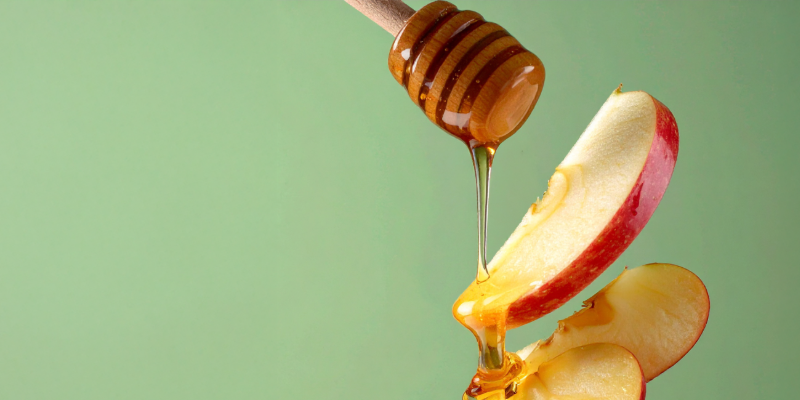Our (Too Early) Guide to Rosh Hashanah

Yes, we know.
It might feel a little too early to start talking about Rosh Hashanah. But if you’ve ever hosted a holiday meal, you know that a little extra planning time is a gift in itself.
Whether you’re the type to start testing recipes in July or you’re just here for the drool-worthy food inspo, we’re here to walk you through the basics of the holiday’s customs, traditions, and, of course, delicious recipes you can start bookmarking now.
The Basics: What Is Rosh Hashanah?
Rosh Hashanah is the Jewish New Year, literally translated from Hebrew as “Head of the Year.” It’s one of the most important holidays on the Jewish calendar, marking the start of the High Holidays, a 10-day period of reflection, repentance, and renewal that culminates with Yom Kippur.
While many people think of New Year’s celebrations as fireworks and countdowns, Rosh Hashanah is deeply spiritual. It’s a time for looking back on the past year, taking stock of one’s actions, and setting intentions for the year ahead.
When Is Rosh Hashanah?
Rosh Hashanah takes place on the first and second days of the Hebrew month of Tishrei. It generally falls in September or early October on the Gregorian calendar. Because the Jewish calendar is lunar, the exact dates shift from year to year.
In 2025, Rosh Hashanah begins at sundown on Monday, September 22 and ends at nightfall on Wednesday, September 24.
Key Customs and Traditions
Hearing the Shofar
One of the most iconic Rosh Hashanah traditions is the blowing of the shofar. A shofar is a ram’s horn that produces a powerful, ancient sound meant to awaken the soul. The shofar is blown in synagogue on both days of the holiday, with a specific sequence of blasts (tekiah, shevarim, teruah) that stir reflection and inspire spiritual renewal.
Attending Services
Rosh Hashanah services are longer than typical Shabbat prayers and include special liturgy, such as the Unetaneh Tokef, which reflects on the themes of life, death, and divine judgment. Many synagogues also use special melodies reserved only for the High Holidays, adding to the atmosphere.
Tashlich Ceremony
On the afternoon of the first day, it’s customary to perform Tashlich, a symbolic casting away of sins. People gather by a natural body of water—such as a river or lake—and toss in breadcrumbs or small pieces of bread, representing transgressions left behind in the past year.
Sweet Foods for a Sweet Year
If there’s one thing everyone agrees on about Rosh Hashanah, it’s that the food is both symbolic and delicious. Sweet flavors are front and center to represent the wish for a sweet year ahead. That’s why honey, apples, pomegranates, and other naturally sweet ingredients make frequent appearances on the holiday table.
Symbolic Foods and Their Meanings
- Apples & Honey – Dipped together as a blessing for a sweet year.
- Round Challah – Symbolizing the cyclical nature of the year and life itself. Often baked with raisins for extra sweetness.
- Pomegranates – Said to have 613 seeds, representing the 613 mitzvot (commandments) in the Torah.
- Carrots – In Yiddish, the word for carrots (meren) sounds like “more,” symbolizing abundance.
- Fish or Ram Head – To be “like the head and not the tail” in the coming year—a wish for leadership and forward momentum.
Setting the Rosh Hashanah Table
The Rosh Hashanah table is about more than just what’s served—it’s about creating a warm, festive, and hopeful atmosphere. Think white or cream linens to symbolize purity, pops of gold to signify blessings, and place settings adorned with small pomegranates or honey jars as thoughtful touches. Some families set out a decorative shofar or arrange seasonal flowers to bring the feeling of new beginnings into the dining room.
Recipes to Start Testing Now
We couldn’t write a Rosh Hashanah guide without talking recipes. Complete with symbolic ingredients to ring in a sweet and meaningful new year, here are a couple classics to consider adding to your holiday menu.
Classic Honey Cake
Why it’s special:
Honey cake is a staple on many Rosh Hashanah tables. The sweetness of the honey mirrors our wishes for the year ahead, and the warm spices bring a comforting, autumnal feel to the meal.
Ingredients:
- 3 ½ cups all-purpose flour
- 1 tbsp baking powder
- 1 tsp baking soda
- ½ tsp salt
- 4 tsp ground cinnamon
- ½ tsp ground cloves
- ½ tsp ground allspice
- 1 cup vegetable oil
- 1 cup honey
- 1 ½ cups sugar
- ½ cup brown sugar, packed
- 3 large eggs
- 1 tsp vanilla extract
- 1 cup strong brewed coffee, cooled
- ½ cup fresh orange juice
- ¼ cup rye or whiskey (optional, for depth of flavor)
Instructions:
- Preheat oven to 350°F. Grease and flour a 9x13-inch baking pan or two loaf pans.
- In a large bowl, whisk together flour, baking powder, baking soda, salt, cinnamon, cloves, and allspice.
- In another large bowl, beat together oil, honey, white sugar, brown sugar, eggs, and vanilla until well blended.
- Stir in coffee, orange juice, and rye/whiskey (if using).
- Gradually fold the dry ingredients into the wet ingredients until just combined. Do not overmix.
- Pour batter into prepared pan(s) and bake for 45–55 minutes, or until a toothpick inserted in the center comes out clean.
- Cool before slicing.
Apple & Pomegranate Salad with Honey-Lemon Dressing
Why it’s special:
Combining two of the holiday’s most symbolic fruits—apples and pomegranates—this salad is fresh, colorful, and perfect as a starter.
Ingredients:
- 3 crisp apples (Honeycrisp or Gala), thinly sliced
- 1 cup pomegranate seeds
- 5 oz baby spinach or mixed greens
- ½ cup candied pecans
- ½ cup crumbled feta or vegan feta
For the dressing:
- 3 tbsp honey
- 2 tbsp fresh lemon juice
- ¼ cup olive oil
- Salt and pepper to taste
Instructions:
- In a large salad bowl, combine apples, pomegranate seeds, greens, pecans, and feta.
- Whisk together honey, lemon juice, olive oil, salt, and pepper in a small bowl.
- Drizzle dressing over salad just before serving and toss gently.
Wrapping Up
Rosh Hashanah is more than just a holiday—it’s a time to reflect, connect with loved ones, and look forward to new opportunities. Whether you’re planning a large family gathering, attending synagogue services, or simply dipping apples in honey at home, taking a little extra time to prepare can make the holiday feel even more meaningful.
So yes, it might be “too early,” but consider this your gentle reminder: the sweetest moments often start with early planning. May your year ahead be as rich as honey, as abundant as the seeds of a pomegranate, and as warm as a freshly baked challah.
Shanah Tovah U’Metukah, wishing you a good and sweet year!
© 2025 by Kosher Eats. Website design and development by 1744 Marketing.
Accessibility | Terms & Conditions | Privacy Policy




